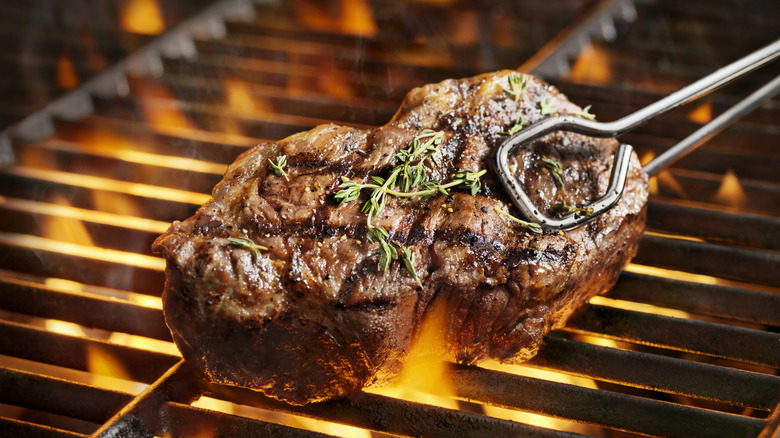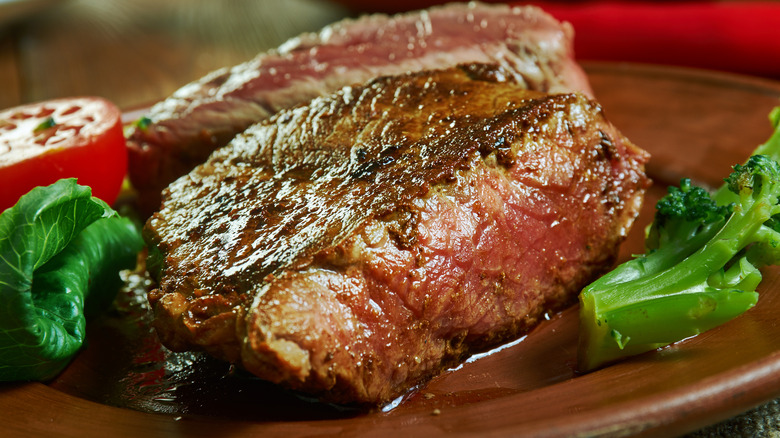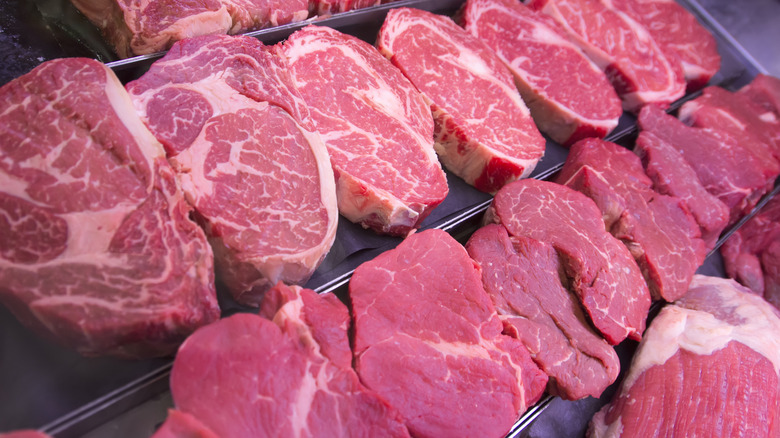Why It Can Pay Off To Grill Your Steak Straight From The Freezer
There are a lot of "correct" ways to grill a steak. Everyone has their own idea on how to grill it, what to grill it with, and even how long to grill it for. While these are all objectively good ideas in their own right, there's probably one way you never expected before: tossing the steak on the grill straight out of the freezer, avoiding waiting for the steak to thaw out fully.
The reason this may sound strange to you is because normally, you let the steak thaw out before you put it on the grill. Although that does have its benefits, skipping the whole thawing process altogether not only means less preparation time but it actually gives you a much more interesting texture. When you place the still-frozen piece of steak on the grill, the exterior of the meat develops a deep black char. On the interior, however, the meat cooks just enough that it develops a rosy-pinkish color similar to a rare or medium rare, but still keeps a moist and tender texture to it. Imagine a steak that looks burnt on the outside and is bloody rare on the inside, as if the steak was suddenly "flash-cooked" in extreme heat.
How exactly does this process work? What is it about a frozen steak that makes such an extreme difference in the exterior and interior textures? Surprisingly enough, this cooking process is actually somewhat similar to another type of steak found in the Pittsburgh area of Pennsylvania.
The interior and exterior cook at different speeds
When you thaw steak out to room temperature, what you're basically doing is bringing both the interior and exterior of the steak to equal temperature. This way, both the interior and exterior of a steak will cook at an even speed when placed on the grill, so you don't have to worry about overcooking the exterior to try and cook the interior all the way through.
With this method, since you're not letting the steak thaw, the exterior and interior will be at different temperatures, When you place the frozen steak on the grill, the exterior is exposed to that heat and begins to cook first, while the interior– still frozen– cooks at a much slower rate. By the time the steak's exterior has that black char, the heat has just managed to cook the interior enough to get that rosy rare color.
If you want to see a steak similar to what we're talking about, you should go and try a Pittsburgh-style steak. This type of steak is also characterized by a dark charred exterior and a bright reddish-pink interior, much like a frozen grilled steak. The idea behind these steaks comes from the story that steel mill workers would use the extreme heat from the blast furnaces to instantly "char" the steak for a quick and easy lunch. While Pittsburgh-style steaks aren't made using blast furnaces today, they are still prepared using direct heat, such as an open, uncovered flame.
Is this method all that safe?
You're probably wondering if this type of method is even a good idea, especially if you're looking at it from a food safety mindset. After all, shouldn't you want the interior of the steak to be fully cooked instead of just "cooked enough?" While it's understandable to have concerns — and if you are not comfortable with this method, you have no obligation to do it — there isn't as much risk as cooking steak to that degree of doneness as there is with other meats.
According to the U.S. Department of Agriculture, frozen meats such as beef can be cooked without thawing, but must be cooked about one and a half times longer than thawed beef would. Raw steak can be eaten safely without any adverse side effects, but it must meet certain conditions before it can be consumed. For example, the meat must come from a trusted supplier, it must be stored properly, and it must be prepared by a skilled, knowledgeable chef.
Of course, just because beef can be consumed (under certain criteria anyway), this doesn't mean all meats are good to eat raw or "rare." Poultry, for example, must be fully cooked no matter if it's frozen or thawed in order to kill off any bacteria. If you or someone you know is either pregnant or immunocompromised, the meat — beef or poultry — must be cooked to a high temperature in order to be consumed safely. It's simply a matter of being diligent in knowing when to use common sense.


